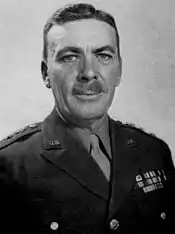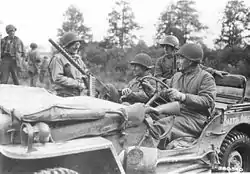Raymond O. Barton
Major General Raymond Oscar "Tubby" Barton (August 22, 1889 – February 27, 1963) was a career officer in the United States Army and combat commander in World War I and World War II. As commander of the 4th Infantry Division during World War II, Barton is one of only eleven U.S. Army general officers who commanded their divisions for the duration of their combat service.[1]
Raymond Oscar Barton | |
|---|---|
 | |
| Nickname(s) | "Tubby" |
| Born | August 22, 1889 Granada, Colorado, United States |
| Died | February 27, 1963 (aged 73) Augusta, Georgia, United States |
| Allegiance | |
| Service/ | |
| Years of service | 1912–1946 |
| Rank | |
| Unit | |
| Commands held | 1st Battalion, 8th Infantry Regiment 8th Infantry Regiment 4th Infantry Division |
| Battles/wars | World War I World War II |
| Awards | Army Distinguished Service Medal Silver Star Legion of Merit Bronze Star |
Background and early career
He graduated from the United States Military Academy class of 1912. As commander of the 1st Battalion, 8th Infantry Regiment he served in Germany from 1917 to 1923, being the last formation to leave.
World War II

He commanded the 4th Infantry Division from 3 July 1942 to 26 December 1944 and led them into battle from D-Day at Utah Beach,[2] to the Liberation of Paris, and into the Battle of the Hurtgen Forest before leaving the command due to health problems on December 27, 1944.
During the war he became friends with Ernest Hemingway who sought his favor as the war correspondent assigned to the division and the two corresponded after.
Hemingway wrote to Barton:
You had one of the greatest divisions in American military history.
During the Battle of Hürtgen Forest on the Weisser Weh stream near Grosshau, Germany General Barton gave up his belt for tourniquet material to medic Russell J. York of his division at York's request. Lives were saved, and a Silver Star was personally awarded to Technician (Medical) 4th Grade York by General Barton for his actions.
Death
Barton died in 1963 and was buried at Westover Memorial Park in Augusta, Georgia.[3]
Popular culture
In the film The Longest Day he is played by Edmond O'Brien. He appears in a scene where he allows his assistant division commander, Theodore Roosevelt Jr. (played by Henry Fonda), to lead the division ashore at D-Day.
References
- Order of Battle, p. 374.
- Harrison, Gordon A., (1951). - CHAPTER VIII: "The Sixth of June: Hitting the Beaches". - Cross Channel Attack. - Washington D.C.: Office of the Chief of Military History, Department of the Army. CMH Pub 7-4. - p.302. - OCLC 1350280.
—REPRINT: (1984). - ISBN 978-0-318-22740-5 - "Raymond O. Barton". Find a Grave. Retrieved October 30, 2010.
Further reading
- Tom Carhart (2002). West Point Warriors: Profiles of Duty, Honor, and Country in Battle. ISBN 0-446-61125-5.
- Utah Beach Forces
| Military offices | ||
|---|---|---|
| Preceded by Fred C. Wallace |
Commanding General 4th Infantry Division 1942–1944 |
Succeeded by Harold W. Blakely |